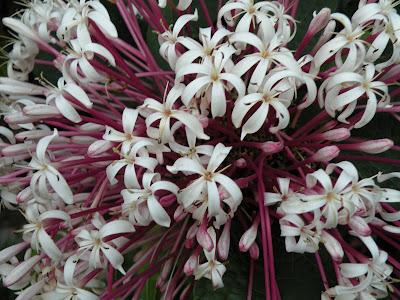
I was finally able to buy my wife her favorite citrus tree, a Key Lime tree, which we Cubans call "limon criollo" or "creole lemon" even though they are not lemons at all but small yellow limes.
Key limes are much smaller, seedier, have a higher acidity, stronger aroma, a much thinner rind than regular limes, and are jucier and more tart than their larger, more common green cousins. The name comes from its association with the Florida Keys where it is best known as the main ingredient in the world-famous Key Lime pie.

Ever since I can remember we always had a Key Lime tree in the backyard. Then, five years ago, the State of Florida ordered all citrus trees in South Florida destroyed because of the advent of Citrus Canker, a lethal disease that ruins citrus fruit and is thought to be highly contagious from tree to tree (although today that is highly debated). The death sentence of our local private trees was passed by the state to protect the central and northern Florida billion-dollar commercial citrus industry. In order to prevent the potential impact on this important Florida commerce, the state ordered what we gardeners call the atomic bomb solution and proceeded to cut down every orange, lime, lemon, and grapefruit tree in South Florida homes and nurseries. Every tree was targeted, no arguments from home or nursery owners--if you had a citrus tree in your back yard or business, it had to go. The massacre of our citrus trees sometime turned ugly with some people threatening state employees (the "executioners" maybe) with violence and police being called. Many lawsuits were filed and all to no avail. Many homeowners with heirloom trees that had been in their yards for decades saw them cut down in one afternoon. Afterward, the state put a moratorium on the sale of citrus trees in South Florida for five years. Now, at last, we are again permitted to grow citrus in our gardens.
Try to imagine a Florida garden without a citrus tree; it's like living in Vermont and not having an apple tree! Thank heaven our citrus is back!
Key limes are much smaller, seedier, have a higher acidity, stronger aroma, a much thinner rind than regular limes, and are jucier and more tart than their larger, more common green cousins. The name comes from its association with the Florida Keys where it is best known as the main ingredient in the world-famous Key Lime pie.

Ever since I can remember we always had a Key Lime tree in the backyard. Then, five years ago, the State of Florida ordered all citrus trees in South Florida destroyed because of the advent of Citrus Canker, a lethal disease that ruins citrus fruit and is thought to be highly contagious from tree to tree (although today that is highly debated). The death sentence of our local private trees was passed by the state to protect the central and northern Florida billion-dollar commercial citrus industry. In order to prevent the potential impact on this important Florida commerce, the state ordered what we gardeners call the atomic bomb solution and proceeded to cut down every orange, lime, lemon, and grapefruit tree in South Florida homes and nurseries. Every tree was targeted, no arguments from home or nursery owners--if you had a citrus tree in your back yard or business, it had to go. The massacre of our citrus trees sometime turned ugly with some people threatening state employees (the "executioners" maybe) with violence and police being called. Many lawsuits were filed and all to no avail. Many homeowners with heirloom trees that had been in their yards for decades saw them cut down in one afternoon. Afterward, the state put a moratorium on the sale of citrus trees in South Florida for five years. Now, at last, we are again permitted to grow citrus in our gardens.
Try to imagine a Florida garden without a citrus tree; it's like living in Vermont and not having an apple tree! Thank heaven our citrus is back!






























